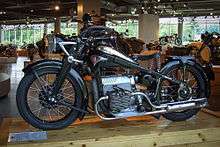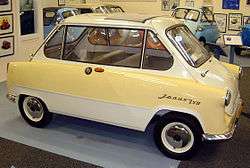Zündapp
 | |
| Industry | Machine tools, motor vehicles |
|---|---|
| Founded | 1917 |
| Defunct | 1984 |
| Headquarters | Germany |
| Products | Detonators, motorcycles, microcars, sewing machines |
Zündapp (aka Zuendapp) was a major German motorcycle manufacturer founded in 1917 in Nuremberg by Fritz Neumeyer, together with the Friedrich Krupp AG and the machine tool manufacturer Thiel under the name "Zünder- und Apparatebau G.m.b.H." as a producer of detonators (Zünder- und Apparatebau is German for Igniter and Apparatus). In 1919, as the demand for weapons parts declined after World War I, Neumeyer became the sole proprietor of the company, and two years later he diversified into the construction of motorcycles.
Following World War II, Zündapp expanded into the microcar, moped and Scooter (motorcycle) markets. The company collapsed in 1984.
Zuendap.biz markets markets bicycle and electric bicycles using the Zundapp name and logo.[1] while Zuendapp.com markets "enduro-sport" motorcycles under the Zundapp brand.[2]
Early history: 1919–45




The first Zündapp motorcycle was the model Z22 in 1921. This was the Motorrad für Jedermann ("motorcycle for everyone"), a simple, reliable design that was produced in large series. Zündapp's history of heavy motorcycles began in 1933 with the K-series. The "K" refers to the type of drivetrain that these models used, Kardanantrieb, meaning enclosed driveshaft with two universal joints. Zündapp introduced the enclosed crankcase (then a novelty). The series encompassed models from 200 to 800 cc displacement and was a major success, increasing Zündapp's market share in Germany from 5% in 1931 to 18% in 1937.
The Zündapp KS600, first released in 1938, had a 28 hp (21 kW) horizontally opposed twin cylinder motor with overhead valves displacing 597 cc (36.4 cu in). The KS600 was often coupled with a Steib sidecar, the BW38 (Beiwagen 1938). The BW38, fitted with the B1 (Boot no. 1) sidecar body was produced between 1938 and 1941 and supplied exclusively to the Wehrmacht. While the KS600 was discontinued and eventually replaced by the purpose-built KS750, its motor was to be the only remnant to live beyond the destruction of war. When Zündapp returned to motorcycle production in the late 1940s, it chose to reuse the KS600's motor to power the KS601 with few modifications.
The Zündapp K800 had unit construction, flat-four engines with shaft drive (a layout adopted by Honda for the Gold Wing in 1974) and were the only 4-cylinder machines used by the German armed forces in World War II.[3]
From 1931 Ferdinand Porsche and Zündapp developed the prototype Auto für Jedermann ("car for everyone"), which was the first time the name Volkswagen was used. Porsche preferred the 4-cylinder flat engine, but Zündapp used a water-cooled 5-cylinder radial engine. In 1932 three prototypes were running. All three cars were lost during the war, the last in a 1945 Stuttgart bombing raid.
From 1936 to 1938 Zündapp produced the KKS500 model. This was the first Zündapp with a foot gear change, and 170 examples were built.[4] From 1940 onward Zündapp produced more than 18,000 units of the Zündapp KS 750.[5] This is a sidecar outfit with a driven side wheel and a locking differential, supplied to the German Wehrmacht.
Zündapp also made aircraft engines including the 9-092, which was used in light aircraft, including the Brunswick LF-1 Zaunkönig (1942) ab initio trainer aircraft.
Postwar: 1945–84



After World War II the company transitioned to smaller machines, notably the "Bella" motor scooter, which was a relatively heavy machine for its type. In 1951 Zündapp released the last of its heavy motorcycle models, but one of its most famous: the KS601 (the "green elephant") with a 598 cc two-cylinder engine. From 1957 to 1958 the company also produced the Zündapp Janus microcar.[6]
In 1958 the company moved from Nuremberg to Munich. Subsequently, the company developed several new smaller models, discontinued the development of four-stroke engines and only produced two-stroke models. Zündapp experienced some success in motorsports with rider André Malherbe winning the 125cc European motocross championships in 1973 and again in 1974.[7][8] Initially, Zündapp scooters and mopeds sold well, but later sales declined and in 1984 the company went bankrupt and closed.
Epilogue
After the bankruptcy, the entire production line and intellectual properties was bought by Xunda Motor Co., Tianjin, China. They produced small Zündapp motorcycles from 1987 till the early 1990s. Zündapp is still in business, but makes Honda based 4-stroke motorcycles and electric mopeds.[9]
Zündapp also had a technical collaboration with Royal Enfield (India) to build mopeds and motorcycles. A dedicated factory was built at Ranipet near Chennai in the early 1980s to manufacture small, lightweight two-stroke motorcycles to be offered along with their flagship Royal Enfield Bullet. Enfield launched two 50 cc motorcycles first, the step-thru Silver Plus and the 3-speed Explorer motorcycle. Later, 175 cc Enfield Fury (based on Zündapp KS175) was introduced as a performance motorcycle. It had 5-speed gearbox, a hydraulic Brembo disc brake and a sleeveless hard chromed cylinder barrel, all were a first on a motorcycle in that country.
Literature
(in German)
- Reiner Scharfenberg, Günter Sengfelder, Siegfried Rauch: Zündapp im Bild.
- Band 1: Die Nürnberger Jahre 1922–1958. Motorbuch-Verlag, Stuttgart 1998, ISBN 3-613-01919-1.
- Band 2: Die Münchener Jahre 1953–1984. Motorbuch-Verlag, Stuttgart 2000, ISBN 3-613-02034-3.
- Siegfried Rauch, Johann Kleine Vennekate (Hrsg.): Zündapp. Neuauflage Zündapp: 60 Jahre Zündapp-Technik. Kleine Vennekate, Lemgo 1996.
- Thomas Reinwald: Nürnberger Motorradindustrie. Podszun, Brilon 2002, ISBN 3-86133-299-X.
- Frank O. Hrachowy: Kleinkrafträder in Deutschland – die ungedrosselten 50er der Klasse 4. Kleine Vennekate, Lemgo 2006, ISBN 3-935517-26-2.
- Uwe Frensel: Zündapp Modellgeschichte von 1952–1984. Ein Leitfaden für Sammler. Heel, Königswinter 2009, ISBN 978-3-89880-504-9.
References
- ↑ http://www.zuendapp.biz/
- ↑ http://www.zuendapp.com/
- ↑ "1938 Zundapp K800 - Barber's Best". Motorcycle Classics. Ogden Publications. 7 November 2012. Retrieved 23 December 2013.
The Zundapp K800 is listed as one of the top 100 machines of the 20th century.
- ↑ Greg Williams (July–August 2009). "1937 Zundapp KKS500". Motorcycle Classics. Retrieved 2009-08-04.
- ↑ Margie Siegal (July–August 2007). "1942 Zundapp KS750". Motorcycle Classics. Retrieved 2009-08-11.
- ↑ Roberts, Andrew (20 November 2011). "Classic Zundapp Janus". The Telegraph. Retrieved 23 December 2013.
The Janus was envisaged as a 'quality bubble car' and Jim Hacking, a microcar expert and proud Zundapp owner, bristles with annoyance at the 2008 Time magazine article claiming that the Zundapp was one of the 50 worst cars of all time.
- ↑ "1973 125cc European motocrosschampionship final standings". memotocross.fr. Retrieved 3 February 2016.
- ↑ "1974 125cc European motocrosschampionship final standings". memotocross.fr. Retrieved 3 February 2016.
- ↑ Xunda Motor Co. Ltd. retrieved 12 Dec. 2010
External links
| Wikimedia Commons has media related to Zündapp. |
| Wikimedia Commons has media related to Zundapp KS 750. |
- Film : Zündapp Z 200 - Subtitles: German and English- production: www.OldtimerbazaR.pl
- Registry: Zündapp Wartime Motorcycle registry and database

